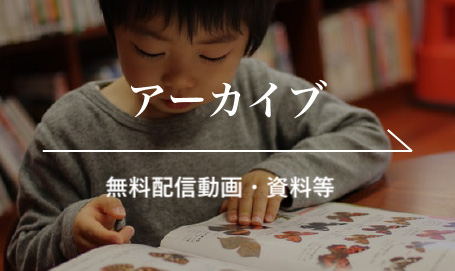< VOLUME 43, No.2 >
Tsunekawa Naoki. An Attempt to Feel Children’s Play and to Contemplate Its Meaning in Nursery Life : Through a Case Analysis of Play from the Viewpoint of Relationship..
Research on Early Childhood Care and Education in Japan, 2005, 43(2), 122-134.
Arguments on children’s play in nursery life tend to be split between “purity” and “usefulness”, or between “direction” and “laissez faire”. This reflects our ambivalence about children’s play. This article noted two attitudes toward play, namely “to feel play” and “to contemplate play”, as factors of that ambivalence, and attempted to integrate them. Based on continuous participant observation in a nursery school, a thick description of a 4-year-old girl’s play with the observer was made. The analysis showed first that the play indicated the development of a relationship between the girl and the observer. Second, that development was made possible by intersubjective relationships with others in her nursery life. Finally, those meanings suggest the significance of children’s play that is a part of whole nursery life as subjective activity.
Keywords: to feel play, to contemplate play, meaning of play, subjectivity, relationship in nursery life
—————–
Nakashima Hisako. A Study of Children’s Self They Want to Show Others : By Participant Observation in One to Two Year Old Nursery Classes.
Research on Early Childhood Care and Education in Japan, 2005, 43(2), 135-147.
The author was engaged in participant observation in one to two year old nursery classes for one year. The purpose was to collect the cases of call-for-attention behaviors and examine the following points; in what circumstances they tended to show or display something to others, to whom they showed, what kind of things or actions they showed and what kind of self-consciousness appeared in their behaviors. In result, the cases indicated that they called for attention when they felt various self in their nursery life; when they had their favorite things, wore their favorite clothes, made various things, found or thought something interesting, and manipulated things or their bodies at will. It was important for them to acquire support from those who observed what they wanted to show.
Keywords: self-consciousness, one-two year old nursery classes, nursery life, participant observation
—————–
Nunomura Shiho. Significance of “Nature Play” in an Early Stage of Childhood : The Study Conducted by Nomura Yoshibei.
Research on Early Childhood Care and Education in Japan, 2005, 43(2), 148-155.
This report introduces one of the educational approaches Nomura Yoshibei has been advocating; “Nature play” in an early stage of childhood. There are three emphases in “Nature play”. First, small children are encouraged to have many opportunities to encounter nature around them and enjoy the natural environment. By doing so, they will learn to live with other living things as a member of the natural world. Secondly, “Nature play” helps to nurture children’s interest in science and art and cultivates their capabilities, which is different from what and how we learn in the school science class. Third, “Nature play” emphasizes the importance of a teacher’s guidance. The aim of “Nature play” by Nomura Yoshibei is to remind us to reconsider our way of life with the acknowledgement that a man is “Child of nature”.
Keywords: Nomura Yoshibei, “Nature play”, “scientific attitude” and “artistic attitude”, a teacher’s guidance, “Child of nature”
—————–
Nishi Hiroko, Noguchi Haruko. An Education Program for Developing Sympathetic Body Awareness of Preschool Teachers : Through the Experience of Expressive Body Movement in College-Level Course Works.
Research on Early Childhood Care and Education in Japan, 2005, 43(2), 156-165.
The purpose of this paper is to investigate how to establish an education program for preschool teachers that will help them develop hearty and sympathetic body awareness when interacting with children. Lately, numbers of studies have proved that interactive physical synchronization” plays a significant role in the ability of preschool teachers to develop their “adaptable and compassionate body attentiveness.” This study qualitatively examines the effectiveness of the empirical model we developed in a previous study of 223 students who completed training programs for preschool teachers at three universities. The empirical results were based on a multidimensional scaling method; they show that a specific professional training program might be effective in helping preschool teachers to achieve a higher degree of interactive physical synchronization, in particular, with respect to indicators representing “intersubjectivity” and “physical sensitivity.”
Keywords: expressive body movement, interactive physical synchronization, multidimensional scaling method
—————–
Matsunaga Aiko. A Study of the Role of the Community Parenting Support Center : To Create “Their Own Place” in the Multiple Aspects of a Situation.
Research on Early Childhood Care and Education in Japan, 2005, 43(2), 166-178.
The purpose of this paper is to examine how the staff of a community parenting support center work to create a place where parents and children can feel as comfortable as if the were in their own place. A case analysis shows that it is important for staff to accept parents and their children without any judgment in order to create such a place. Exchanging information and communication are also important factors in the creation of the sense of “their own place.” The situation can form new human relationships in which the difficulties of parenting are transformed into the pleasures of parenting. The result suggests the possibility of a different concept of “community” from the concept of community used in the concept of “community welfare”.
Keywords: a community parenting support center, their own place, community welfare
—————–
Negayama Koichi, Hoshi Miwako, Tshuchiya Michiko, Matsunaga Seiko, Siomi Toshiyuki. A Study of Infants’ Crying at Day Nurseries through an Observational Record by Nursery Teachers.
Research on Early Childhood Care and Education in Japan, 2005, 43(2), 179-186.
This study investigates conditions surrounding infants’ crying at day nurseries, and aims to examine the quality of daycare. In the day nurseries, 570 babies were observed. For each subject, the state of each period of crying, as well as its cause and the adult’s techniques used to calm the child, were recorded during one day by his/her nursery teacher. The results show: 1. As a whole, the frequency of crying was highest in the morning and then declined; 2. The causes of crying were interpreted by the adults as mostly physical, though social causes increased with age in months; 3. Crying interpreted as having a physical origin was nevertheless dealt with by applying social techniques like holding; 4. The duration and the strength of a baby’s crying were related significantly to the length of professional experience of his/her practitioner.
Keywords: cry, infant, nursery, quality of daycare, nursery teacher
—————–
Okada Tatsumi. The Understanding of a Child and the Relation between the Child and Myself.
Research on Early Childhood Care and Education in Japan, 2005, 43(2), 187-193.
In childcare, we consider a child and unconsciously relate to her/him. The objective of this paper is to clarify the relationship between a child and me. The observation of this interrelationship should be very useful for understanding childhood care. My journal of childcare was analyzed and examined. The result shows that information about the child obtained through its relationship with me modified my idea about the child and subsequently affected the relationship between us. It is very difficult to point out a particular cause because the idea is a complex one interrelated with action. However, this research would provide an important perspective to consider my own childcare.
Keywords: relation between the child and myself, journal of childcare, modify
—————–
Sano Tomoe. The Historical Development of the In-Service Training for Kindergarten Teachers in the Pre-War Japan.
Research on Early Childhood Care and Education in Japan, 2005, 43(2), 194-201.
In this paper, I examined in-service training for kindergarten teachers in Pre-War Japan. There were the activities for the kindergarten teachers in the Meiji Period. For example, there were short courses and lecture meetings of various kinds. There’s no denying that the in-service training had some systematical problems, but they were effective in the following ways: 1. In Meiji Period, The in-service training connected with a kindergarten teacher’s needs because the kindergarten educational-related organization offered those activities. 2. The kindergarten teachers themselves found problems in their actual activities, and shared their knowledge and techniques through mutual conferences and studies. 3. The cooperation of the kindergarten educational-related organizations led to the development of the In-Service Training for kindergarten teachers.
Keywords: in service training, kindergarten teachers, kindergarten educational-related organizations
—————–
Kotani Takanori. Children’s Sense to Understand the Concept of Quantity in Terms of Relations between Language and Peer Relationships : From the Observation of 3-4 Year Old Children in Kindergarten Life.
Research on Early Childhood Care and Education in Japan, 2005, 43(2), 202-213.
rights: 日本保育学会rights: 本文データは学協会の許諾に基づきCiNiiから複製したものであるrelation: isVersionOf: http://ci.nii.ac.jp/naid/110004799494/The purpose of this study is to clarify children’s sense to understand the concept of quantity in terms of their language and peer-relationships. A specific circumstance in which 3-4 year old children used words related to quantity was recorded and changes of their lives were analyzed. First, the result shows that the interaction between division of viewpoints related to quantity and acquisition of language related to quantity formed the concept of quantity. Second, changes of peer-relationships and their play activities changed necessary viewpoints related to quantity. Third, from the point of relation between language and peerrelationship, expansion of verbal expression helped to share the purpose of their play activities. The purpose of this study is to clarify children’s sense to understand the concept of quantity in terms of their language and peer-relationships. A specific circumstance in which 3-4 year old children used words related to quantity was recorded and changes of their lives were analyzed. First, the result shows that the interaction between division of viewpoints related to quantity and acquisition of language related to quantity formed the concept of quantity. Second, changes of peer-relationships and their play activities changed necessary viewpoints related to quantity. Third, from the point of relation between language and peerrelationship, expansion of verbal expression helped to share the purpose of their play activities.
Keywords: children’s sense to understand the concept of quantity, language, peer relationship
—————–
Nanakida Atsushi. The Early Childhood Education Reforms in New Zealand : From the Integration with Education and Care to Construction of the National Curriculum.
Research on Early Childhood Care and Education in Japan, 2005, 43(2), 214-222.
This research examines how the reforms in 1986-1996 were carried out under the rhetoric of increasing equity and quality within the early childhood education in New Zealand. It is evident that the role of government in early childhood policy issues is becoming more intrusive and prescriptive. There is a delicate balance of this being a good or bad thing for early childhood. It is necessary to uphold and protect this intrusion for early childhood philosophy and supports, so that the researchers encourage quality programs. Te Whariki, or “National Early Childhood Curriculum,” is co-opted for political or pedagogical reasons outside of the current needs of early childhood education.
Keywords: quality of early childhood education, integration with education and care, curriculum, New Zealand
—————–
Tamiya Yukari, Otsuka Akira. upport for Parents of Young Children with Mild Developmental Disorders : A Case Study at An Attached Kindergarten to S University.
Research on Early Childhood Care and Education in Japan, 2005, 43(2), 223-232.
This study examines how kindergarten teachers should contact specialists and cooperate with specialized institutions in order to support parents of “gray zone” children who have mild developmental disorders to realize their children’s schooling. The result of this case study suggests three important points for a teacher in charge of the child to support her/his parents. First, to build a reliable relationship with her/his parents doing feed back of positive appearance. Second, not only to provide the best information to the parents but also to give them initiatives to think by themselves. Third, to support the parents when they are shaken by the difficult decisions related to their children’s future course. It is essential that teachers cooperate with specialists to develop specific knowledge and skills. For this purpose, a coordinator of special support education is necessary at kindergarten.
Keywords: mild developmental disorders, support for parents, consultation, case study, kindergarten
—————–
Nisino Misako. A Study on the Relationship between Mothers’ Instructive Leadership and their Children’s Temperament.
Research on Early Childhood Care and Education in Japan, 2005, 43(2), 233-242.
The purposes of this research are to create a gauge to measure “educational leadership” in mother-child interactions and to examine the relationship between mothers’ educational leadership and types of child treatment, including fathers’ participation in childcare. The data obtained from 284 mothers who were bringing up small children was analyzed. Analysis of educational leadership showed three factors; Goal achievement support,” “Compulsion by a threat as punishment,” and “Inconsistent bringing-up procedures.” Analysis of parents’ attitudes about childcare revealed two factors; “feeling the burdens of child-rearing” and “feelings of child-rearing fulfillment.” It was clear that fathers’ participation in childcare increased “Goal achievement support” and “a feeling of childcare fulfillment” and decreased “a feeling of childcare burden.” The results support the validity of a child temperament type and suggest that a mother’s educational leadership is influenced by her child’s temperament type.
Keywords: educational leadership, child temperament type, fathers’ participation in childcare
—————–









